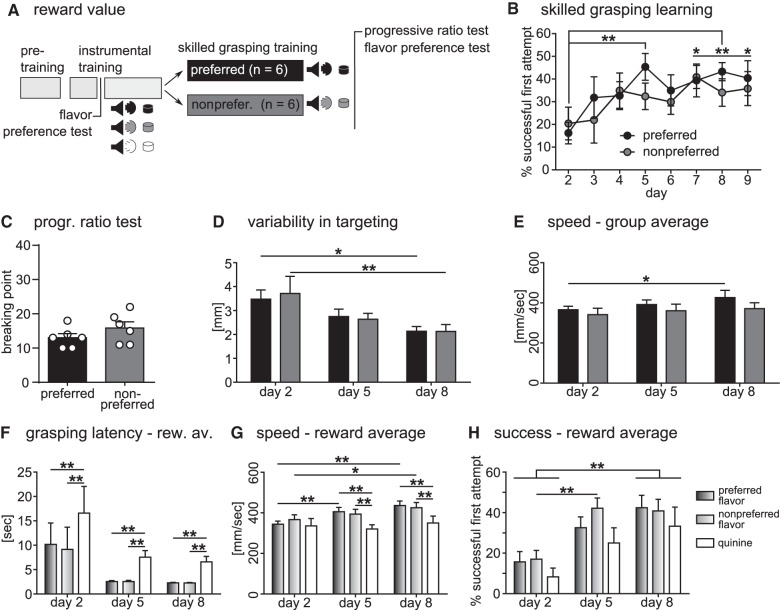Figure 3.
Reward value effects on skilled grasping. (A) Experimental design. During instrumental training, tone cues signaled appearance of a preferred (black), nonpreferred (gray), or quinine-flavored (white) pellet. During skilled grasping training, the preferred group had a high probability of being presented with their preferred flavor and paired tone, whereas the nonpreferred group had a high probability of being presented with their nonpreferred flavor and paired tone. Quinine-flavored pellets were interspersed at a low probability for both groups. (B) Both groups showed an increase in success rate over time in the skilled grasping task (time: F(7,70) = 4.63, P = 0.0003, group: F(1,10) = 0.34, P = 0.57), which was significant for the preferred group when tested by multiple comparison analysis (day 2 versus 5 and 8: P < 0.01, day 2 versus 7 and 9: P < 0.05). (C) Progressive ratio test did not show a difference in nose-poke response breaking point between groups (P = 0.22). N = 6 rats for both groups. (D) Variability of targeting trajectory was reduced with training in both groups (time: F(2,18) = 11.21, P = 0.0007) with a significant reduction from day 2 to 8 (preferred: P < 0.05, nonpreferred: P < 0.01). (E) Average grasping speed showed a significant effect of training (time: F(2,18) = 3.65, P = 0.047), with a strong increase between days 2 and 8 for the preferred group (P < 0.05). (D,E) Preferred n = 6, nonpreferred n = 5. (F–H) Data averaged according to reward flavor type, n = 12 matched values for all types, except speed: n = 10, six preferred group, four nonpreferred group. (F) Latency to complete a grasping attempt after a nose-poke response showed a strong effect of reward type (F(2,22) = 42.42, P < 0.0001). Over the course of grasping training, grasping latency was significantly slower for quinine-flavored pellets than preferred or nonpreferred ones (P < 0.01). (G) Increase in movement speed with training was significant and affected by reward type, showing a significant interaction (time: F(2,18) = 5.54, P = 0.013; reward type: F(2,18) = 8.23, P = 0.003; interaction: F(4,36) = 2.80, P = 0.04). Grasping speed only significantly increased with training for preferred (P < 0.01) and nonpreferred pellets (P < 0.05), leading to significantly faster speeds by days 5 and 8 compared with quinine-flavored pellets (P < 0.01). (H) Successful pellet retrieval showed a strong increase with training and a significant effect of reward type (time: F(2,22) = 12.91, P = 0.0002; reward type: F(2,22) = 4.66, P = 0.021). Success rate for all reward types increased significantly from day 2 to 8 (P < 0.01), and from day 2 to 5 for nonpreferred flavored pellets (P < 0.01). All data are shown as means ± SEM.

